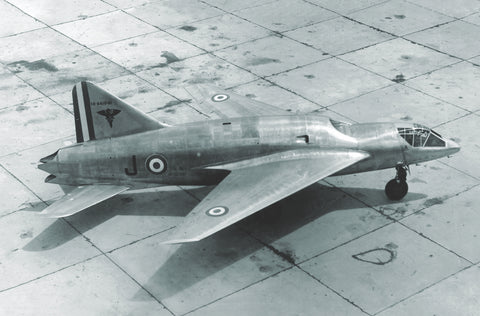
Mystery Ship: Can you identify this winged Quasimodo?
As France began to recover from World War II, its once-formidable aviation industry was revived just as the jet age was forcing a major reappraisal of aircraft design. Jet experiments began producing a fascinating variety of aircraft, ranging from the sublime to the absurd to the just plain weird. One such product of those pioneer years, the Sud-Est Aviation Grognard, looks almost grotesque in retrospect, but there was logic behind it.
When the Armée de l’Air issued a specification for a jet ground-attack plane in 1948, Sud-Est’s engineers were ready with a concept they’d been working on since 1945. First flying on April 30, 1950, after a somewhat protracted development, the Sud-Est SE.2410 was intended to have two SOCEMA TGAR 1008 turbojet engines, but for the time being it used a pair of Hispano-built Rolls-Royce Nene 101 turbojets producing 4,940 lb. of thrust each, for a projected maximum speed of 645 mph, a 530-mile range and a ceiling of 38,050 feet. To maintain symmetry and controllability if one powerplant failed, the engines were stacked one atop the other midway down the fuselage, with the upper staggered slightly ahead of the lower. There was one large dorsal intake up front and two exhausts in the rear. (This arrangement proved to be a rarity among jets but was used with success on the English Electric Lightning interceptor.) The pilot sat up front, an ideal position for ground attack, but with a framed canopy rather than one of the bubble canopies that were already demonstrating their superior visibility and reduced drag. A final odd touch was the tailplane, which was mounted low on the aft fuselage, looking like an afterthought but kept well clear of the exhausts.
The SE.2410 was 51 feet 6 inches long and 17 feet tall. The wings, set at a 47-degree angle, were 45 feet 6 inches in span with a wing area of 495 square feet. Its armament was to have included two 30mm DEFA cannons, which were never installed, as well as four 550-lb or two 750-lb. bombs or up to 12 rockets. It could also mount up to four Matra T-10 air-to-air missiles under the wings, which did gain the Grognard a niche in aviation history as being the first French airplane to fire air-to-air guided missiles.
Given its role in support of ground troops, Sud-Est’s design team nicknamed it the Grognard (“grumbler,” an affectionate term for Emperor Napoleon I’s elite “Old Guard”). A lot of its test pilots and ground crewmen, however, were inspired by its compact but less-than-graceful layout to call it le Bossu (“hunchback”).
Sud-Est planned to advance the Grognard with three more prototypes but ended up producing only one more. Making its maiden flight on February 14, 1951, the SE.2415 Grognard II was 2-seater with radar and an operator, whose altered center of gravity was countered by reducing the wing sweep to 32 degrees. Given the altitudes at which the crew were expected to operate, the cockpit was not pressurized.
While the first prototype had flown well from the start, the Grognard II experienced tail flutter and was damaged in a belly landing. It was the rapidly accelerating state of the art, however, that ultimately brought the project to an end. In 1952 the Armée de l’Air altered its requirements for something more versatile and Sud-Ouest Aviation produced the goods with a newer, more promising design that entered service in 1954 as the SO.4050 Vautour (“vulture”). The Grognard continued to fly as a test bed and Grognard II soldiered on the ground as a target until 1954, when both aircraft were scrapped.
